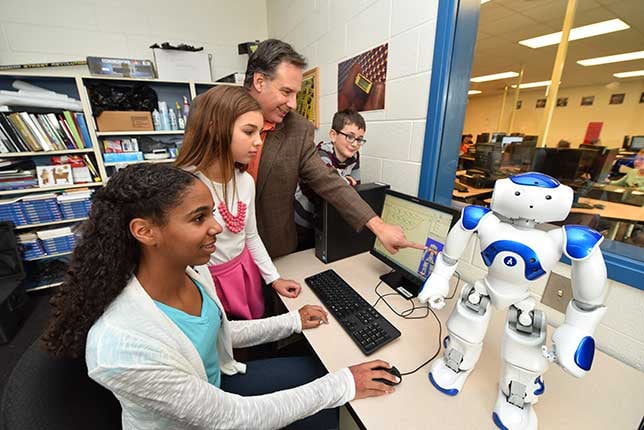I just came across some school-rating figures that surprised me: according to the personal finance website WalletHub based in Washington DC, South Carolina public schools were rated 45th in the nation in educational quality in 2015. That’s 45th in a field of 51. That’s not a good score. The reason this low score surprised me is that I had recently read an interesting Internet post that described at least one South Carolina school district as very up-to-date, progressive and STEM oriented. I guess I thought that would be the same for the entire state!
That school district is Fort Mill school district, Fort Mill, South Carolina, not far from Charlotte. Fort Mill School District (FMSD), will operate a total of 15 schools, composed of nine elementary schools, four middle schools, and two high schools with 104 full-time teachers educating almost 12,000 students during the 2016-2017 school year.
Realizing the importance of STEM education and recognizing how effective robots are with teaching STEM-skills, the district’s 104 teachers will be assisted with the STEM education of those students by two humanoid NAO robots purchased by the district in March of 2016. The money for these two robots came from selling the school district’s old computers. Why, you might ask, did the district go with the French company Aldebaran’s robot NAO, when there are a number of other humanoid robots on the market.
 Fort Mill Middle school educator Frank DiMaria uses robots as an interdisciplinary tool to help students learn problem-solving and gain skills they'll need in the future
Fort Mill Middle school educator Frank DiMaria uses robots as an interdisciplinary tool to help students learn problem-solving and gain skills they'll need in the future
Well, according to one school-staffer instrumental in the decision, One of the things we liked about the NAO is that it is open-ended. It doesn't have to be a rote kind of curriculum. You learn the basics, and then you can use your creativity to really have it do what you want it to do. The student has a lot of flexibility.
Another said, One of the most rewarding aspects of teaching with NAO robots is stepping back and observing as students tackle a problem. By its very nature computer programing requires steadfast trial and error. Students write code and test it over and over again until it is flawless. And still another teacher related how he had studied the literature discussing the effectiveness of NAO robots in the teaching--and reaching--of children with autism.
To get the best use out of their new digital teaching assistants, the school system plans to introduce the basics of programming in the fourth grade. In the fifth grade those same students can start programming the robots to do their own thing. The plan is that by middle school the students are capable of creatively programming the robots “to do some really interesting things.”
to introduce the basics of programming in the fourth grade. In the fifth grade those same students can start programming the robots to do their own thing. The plan is that by middle school the students are capable of creatively programming the robots “to do some really interesting things.”
STEM education is absolutely necessary to our nation’s fiscal well-being. And while South Carolina’s schools are rated are near the bottom of the educational well, pro-active school systems like Fort Mill are evidence that that isn’t going to always be the case. A RAS robot "hats-off"to Fort Mill schools!

